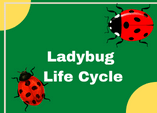The Ladybug Life Cycle Diagram Game Online
The ladybug life cycle diagram game online for students to practice. Check out how a the ladybug goes from egg to adult through metamorphosis. Biology lesson for students from 2nd to 7th grades.
 A Ladybug's life cycle is very simple, but you'll be surprised to learn that the process can take 4 to 8 weeks. The larva attaches itself to a leaf by its tail and becomes a pupa within a week. The adult Ladybug lives about one month, but it often lasts a little longer than that. The adult stages of this life cycle are described below. During this phase, the adult ladybugs feed on aphids, mealybugs, insect eggs and pollen. They then mate with their new partner.
A Ladybug's life cycle is very simple, but you'll be surprised to learn that the process can take 4 to 8 weeks. The larva attaches itself to a leaf by its tail and becomes a pupa within a week. The adult Ladybug lives about one month, but it often lasts a little longer than that. The adult stages of this life cycle are described below. During this phase, the adult ladybugs feed on aphids, mealybugs, insect eggs and pollen. They then mate with their new partner.
Once the eggs hatch, the female ladybug does not wait until the following spring before laying more eggs. The male does not play a role in egg laying. After mating, the female ladybug will lay as many as 300 eggs. The clutch size varies from twelve to twenty eggs. The female ladybug will lay her eggs near a colony of aphids (aphids are the larva's natural food source). The eggs hatch in a matter of 5-7 days and the young are ready to move out into the world.
Once the two adult ladybugs have mated, the pupa stage begins. The pupae feed on soft-bodied insects and will not discriminate when it comes to food sources. The larvae are unable to fly, so they will only feed on the leaves they are on. Once they reach a considerable weight, the adult ladybug will begin mating with its new mates. The entire process takes about a week.
The larvae are nocturnal. This means that the ladybug functions mostly at night at this stage. They molt four times before pupating. The new ladybug is a light, soft-winged creature. During the pupa stage, the new adult will take a few days to harden its exoskeleton. This is the stage at which a ladybug is ready to fly. It will feed on the aphids in its new home, and will eventually start to feed on more aphids on the plant.
The third stage of the ladybug's life cycle is the pupa. This is the time when the adult ladybug begins eating and developing. It also needs a constant source of food because it will starve if it does not eat for a few days.
The next stage of the ladybug's life cycle is the emergence of the adult. It has six legs and two antennae. As the female ladybug matures, it will also produce a clutch of about 300 eggs. It will molt several times during the first three weeks, which will make the adult female a much bigger creature. She will lay eggs in the spring, for around five to six months.
Ladybugs are beautiful and colorful insects which kids are fond of drawing right from when they were young. Its life cycle is quite an interesting one. Begin learning about it by playing the interactive game above. You can hit the reset button each time to restart all over again. Have fun learning about the life cycle of a ladybug.
In the UK system of education, this is equivalent to science for year 2, year 3, year 4, year 5, year 6, year 7 and year 8.
